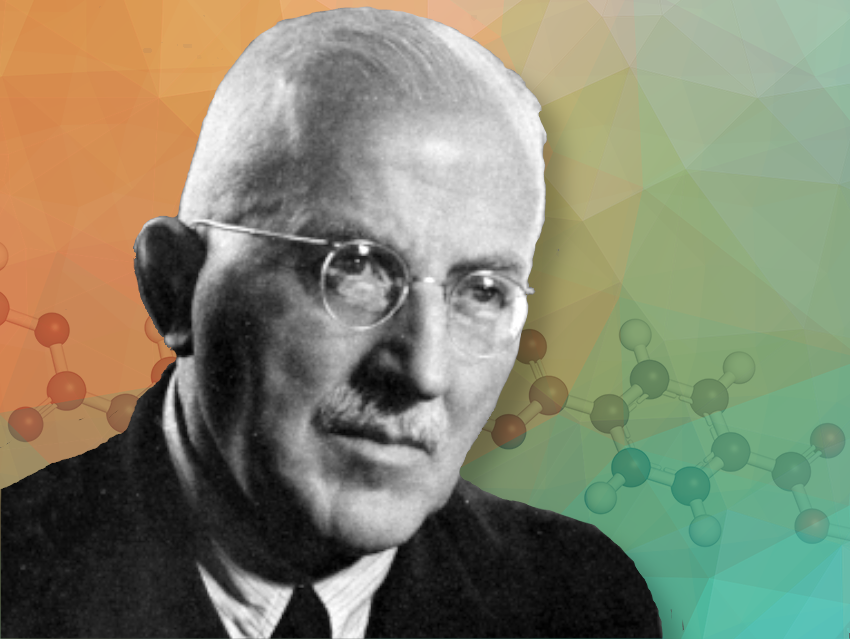Hermann Staudinger, the “father of polymer chemistry”, was born on March 23, 1881, in Worms, Germany. He studied chemistry at the Technical University in Darmstadt, Germany, and in 1900, he moved to Munich to work in Adolf von Baeyer’s laboratory for two years. After yet another relocation, he received his Ph.D. in organic chemistry from the University of Halle, Germany, in 1903 under the supervision of Daniel Vorländer.
In the fall of the same year, Staudinger was offered a position with Johannes Thiele at the University of Strasbourg in today’s France. There, in 1905, he discovered the first ketene (diphenylketene) while trying to build on Gomberg’s research on stable radicals. The work was well received and contributed to an offer for a position at the University of Karlsruhe, Germany, where he moved in 1907. Some of the work he did in Karlsruhe foreshadowed his later successes in macromolecular chemistry, such as the synthesis of isoprene and butadiene and research into the polymerization of ketenes.
In 1912, Staudinger joined the Swiss Federal Institute of Technology (ETH) in Zurich as Director of the chemical institute. Here, in 1919, he discovered the eponymous Staudinger reaction, a method of reducing an azide to an amine using phosphines. It was also in Zurich that Staudinger developed his concept of polymerization while working on rubber: He proposed that materials such as rubber were covalently bound polymers with a high molecular weight, as opposed to colloid aggregates of smaller molecules.
He presented his hypothesis in the seminal paper “Über Polymerisation“, published in 1920. At first, the theory faced strong objection from the community, as it was commonly believed that compounds with such high molecular weights could not exist. Over the years, however, Staudinger provided ample experimental evidence, investigating the reactivity of rubber and using viscosimetry to measure molecular weights. The concept was slowly accepted in the late 1920s and early 1930s. Meanwhile, the chemical industry mostly ignored the academic controversy and kept producing vulcanized rubber, celluloid, and bakelite, and later developed nylon, polyethylene, and many other useful polymers.
During this time, Hermann Staudinger moved to the University of Freiburg, Germany, where he worked from 1926 until his retirement in 1951. In his later career, he focused on biological macromolecules. He founded the first polymer chemistry journal, Die Makromolekulare Chemie (today’s Macromolecular Chemistry and Physics), in 1940. His decades-long effort in supporting and promoting his concept of polymers was honored in 1953, when Staudinger received the Nobel Prize in Chemistry “for his discoveries in the field of macromolecular chemistry”. Hermann Staudinger died on September 8, 1965.
Hermann Staudinger is the answer to Guess the Chemist (45).
References
- Hermann Staudinger and the Origin of Macromolecular Chemistry,
Rolf Mülhaupt,
Angew. Chem. Int. Ed. 2004, 43, 1054–1063.
DOI: 10.1002/anie.200330070 - Hermann Staudinger and the Future of Polymer Research Jubilees – Beloved Occasions for Cultural Piety
H. Ringsdorf,
Angew. Chem. Int. Ed. 2004, 43(9), 1064–1076.
DOI: 10.1002/anie.200330071 - Hermann Staudinger 1881–1965 (in German),
Heinrich Hopff,
Chem. Ber. 1969, 102, XLI–XLVIII.
DOI: 10.1002/cber.19691020502
Selected Publications by Hermann Staudinger
- The insoluble polystyrene,
H. Staudinger, W. Heuer, E. Husemann, I. J. Rabinovitch,
Trans. Faraday Soc. 1936, 32, 323.
DOI: 10.1039/tf9363200323 - Viscosity investigations for the examination of the constitution of natural products of high molecular weight and of rubber and cellulose,
H. Staudinger,
Trans. Faraday Soc. 1933, 29, 18.
DOI: 10.1039/tf9332900018 - Über Polymerisation (in German),
H. Staudinger,
Ber. Dtsch. Chem. Ges. 1920, 53, 1073–1085.
DOI: 10.1002/cber.19200530627 - Über neue organische Phosphorverbindungen III. Phosphinmethylenderivate und Phosphinimine (in German),
H. Staudinger, Jules Meyer,
Helv. Chim. Acta 1919, 2, 635–646.
DOI: 10.1002/hlca.19190020164 - Ketene, eine neue Körperklasse (in German),
Hermann Staudinger,
Ber. Dtsch. Chem. Ges. 1905, 38, 1735–1739.
DOI: 10.1002/cber.19050380283
Also of Interest
- Commemorating Hermann Staudinger,
ChemViews Mag. 2011.
It is 130 years since the birth of Hermann Staudinger, the father of polymer chemistry



